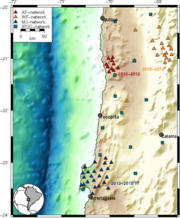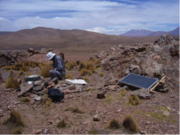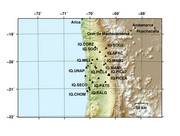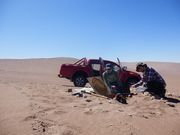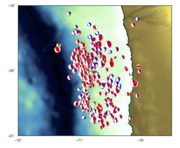West--Fissure-, Atacama-Fault and Mejillones temporary seismic networks
Description
We installed three temporary seismic networks in order to monitor micro-seismicity at the Atacama and West Fissure Fault System (AF and WF) and on the Mejillones peninsula (MJ) in Northern Chile. The subnet around the West Fissure Fault System was operated during the period between November 2005 and November 2009 and again from March 2010 until March 2012. The Atacama Fault subnet recorded from March 2010 to March 2012. From June 2013 until October 2015, we deployed the seismic stations on Mejillones.
The seismic monitoring system around the West Fissure Fault System covers an area of approx. 100 times 80 km at elevations between 3000 m and 5000 m a.s.l. and consists of average 11 surface stations with 3-component seismometers of type Mark L4-1Hz. The data recording is continuous at a sample rate of 200Hz. Data loggers are Earth Data PR-24. Power is supplied by a solar panel with a 12V battery backup.
The seismic monitoring system around the Atacama Fault (AF) System covers an area of approx. 40 times 30 km at elevations between 600 m and 1000 m a.s.l. and consists of 10 surface stations, instrumentation is the same as in the West Fissure (WF) net.
The seismic monitoring system of the recently (2013) installed net at the Mejillones peninsula - a cooperation with the Universidad Católica del Norte in Antofagsta - covers an area of approx. 80 times 70km at elevations between 120m and 1400m a.s.l. and consists of 23 surface stations, instrumentation is the same as in the WF net.
Until 2012 the WF and AF networks recorded waveforms of over 7000 weak seismic events. These micro-earthquakes witness a variety of seismogenic processes such as metamorphic mineral reactions, fluid migration or deformation due to tectonic stress.
The localizations of the seismic events already provide a clear image of the earth's interior in this region: large continental fault zones and a triple seismic zone within the subducting slab can be clearly identified. The deeper analysis of the data set promises to reveal previously unresolved details of the subduction process and its related phenomena.
Date: 2005 - 2015
Partners and People
Contact:Wasja Bloch, Jörn Kummerow, Pablo Salazar, Serge Shapiro, Peter Wigger, GEOFON Data Centre
Partners: Free University Berlin, Universidad Catolica del Norte, GFZ German Research Centre for Geoscience
Data
Data of the West Fissure and Atacama networks are available at the GFZ Seismological Data Archive (network code: 8F) and may be cited as documented under doi.org/10.14470/3S7550699980. The access to these data is restricted.
Selected Publications
Bloch, W., J. Kummerow, P. Salazar, P. Wigger, and S. A. Shapiro (2014), High-resolution image of the North Chilean subduction zone: seismicity, reflectivity and fluids, Geophysical Journal International, 197(3), 1744-1749, doi.org/10.1093/gji/ggu084
Salazar, P., J. Kummerow, P. Wigger, S. Shapiro, and G. Asch (2017), State of stress and crustal fluid migration related to west-dipping structures in the slab-forearc system in the northern Chilean subduction zone, Geophysical Journal International, 208(3), 1403-1413, doi.org/10.1093/gji/ggw463
Schmelzbach, C., J. Kummerow, P. Wigger, A. Reshetnikov, P. Salazar, and S. A. Shapiro (2016), Microseismic reflection imaging of the Central Andean crust, Geophysical Journal International, 204(2), 1396-1404, doi.org/10.1093/gji/ggv530
Iquique Local Network (ILN) and PicArray
Description
The Iquique Local Network (ILN) as one component of the International Plate boundary Observatory Chile (IPOC) is a seismological network of 20 stations around the North Chilean harbour city of Iquique. With its average station spacing of approximately 25 km, the network aims at recording small to moderate seismic events to verify the crustal structure and seismic behaviour of the subduction interface in this region. Since the general task of the IPOC is to monitor the deformation signal before a large earthquake in a brought frequency range, the data of the ILN should provide insight in processes along material boundaries and geometrical features to investigate such an 'earthquake preparation phase' on a local scale. The ILN was originally built as a long term temporal deployment, also supporting hazard analysis for Iquique and the surrounding region. It hosts the nearest station to the coast which is especially important for investigating tsunamigenic earthquakes and their related hazard.
The PicArray was deployed in November 2013 in the vicinity of the village of Pica. The site was chosen as a central spot with respect to the former Northern Chile seismic gap, the availability of a very quiet station from the ILN, the lack of significant noise sources, and the ground conformation, well suited to host a small scale array. The seismic array, originally composed of 9 broadband stations, had an aperture of about 3 km. The PicArray installation aimed to enhance the seismological target of the former ILN configuration, allowing the application of beamforming and array based techniques to analyse the shallow seismicity at the plate interface, the intermediate and deep focus seismicity below Northern Chile and neighbouring regions and to analyse microseismicity and seismicity in the vicinity of the Pica village.
In November 2017, the PicArray setup was further modified, redeploying some of the PicArray installation to build a small network at about Lat 21°S, aiming to better monitor the slab at the southern edge of the 2014 Mw 8.2 Iquique earthquake rupture area.
Partners and people
People involved: Simone Cesca, Monika Sobiesiak (Christian-Albrechts-University of Kiel), Torsten Dahm, Stefan Mikulla, Carlos Tassara (UNAP Iquique), Manuel Olcay (UNAP Iquique)
Partner institutions: GFZ Helmholtz Centre for Geosciences, UNAP Iquique, Christian-Albrechts University Kiel Contact: Simone Cesca, Torsten Dahm, GEOFON Data Centre
Contact: Simone Cesca, Torsten Dahm, GEOFON Data Centre
Data
Data are available at the GFZ Seismological Data Archive (network code: IQ, doi.org/tbd) and documented by a Scientific Technical Report Data (doi.org/tbd). The access to these data is restricted
Selected Publications
Cesca, S., F. Grigoli, S. Heimann, T. Dahm, M. Kriegerowski, M. Sobiesiak, C. Tassara, and M. Olcay (2016), The M w 8.1 2014 Iquique, Chile, seismic sequence: a tale of foreshocks and aftershocks, Geophysical Journal International, 204(3), 1766–1780, doi.org/10.1093/gji/ggv544
Cesca et al. (2017) Data Report for ILN PicArray (in prep.)
Tilmann, F., Schurr, B., Cesca, S., Dahm, T., Saul, J., Palo, M., Moreno, M., Bedford, J., Oncken, O., Wang, R., Zhang, Y. (2016): Neue Einsichten in den Ablauf großer Erdbeben: Kombination innovativer Analyseverfahren erlaubt Rekonstruktion von Bruchverläufen. - System Erde, 6, 1, pp. 24—31, doi.org/10.2312/GFZ.syserde.06.01.4
MINAS, temporary MINi ArrayS within the frame of IPOC
Description: Within the MINAS Project 2011/2013 three seismic mini-arrays were installed for two years (1 January 2011 to 31 December 2013) within the IPOC observatory. Two mini-arrays were located in the vicinity of IPOC stations PB02 and PB07, and a third array to the east of these stations near the village of Quillagua. Each array has 10 elements and an aperture in the km range. The study area lies just to the north of the northern boundary of the rupture area of the Tocopilla earthquake of 2007 (Mw=7.7) and just above or slightly to the east of the downdip limit of plate interface seismicity. This project was co-funded by the Geophysical Instrument Pool Potsdam (GIPP).
Date: 2011 - 2103
Contact: Günther Asch, Bernd Schurr, GEOFON Data Centre
Data: Data are available at the GFZ Seismological Data Archive (network code: 5E, doi:10.14470/ab466166) and documented by a Scientific Technical Report Data (doi:10.2312/GFZ.b103-14036). The access to these data is restricted until May 2017.
Lastarria volcano experiment
Description: The seismic network of the Lastarria volcano experiment 2016 in Northern Chile consists of 6 stations surrounding the fumarole field at Lastarria volcano. These stations were operative during one month with the final purpose of detect changes in the hydrothermal system triggered by passing of seismic waves produced by artificial explosions.
Date: 2016
Contact: Thomas Walter, Martin Zimmer
Data: Waveform data are available from the GEOFON Data Centre (network code 2G, doi.org/10.14470/7T7561754109) and are restricted until 31 December 2019.
Seismic monitoring at Lascar volcano after 2014 Iquique earthquake
Description: The network consists of 5 stations covering the volcanic cone flanks of the north Chilean Lascar volcano. These stations were operative during one year with the final purpose of detect likely changes in the seismic activity of Lascar after the 2014 Iquique earthquake.
Date: 2014 - 2015
Contact: Thomas Walter, Martin Zimmer, GEOFON Data Centre
Data: Waveform data are available from the GEOFON Data Centre (network code 8E, doi.org/10.14470/3R7569753098) and are restricted until December 31 2018.
HART-PISAGUA Project Chile
Description: Temporary seismological network of 23 broadband seimometers was installed between 11-25 April 2014, only few days after the 2014-04-01 Mw 8.1 Pisagua Earthquake by the Hazard and Risk Team (HART) of the GFZ Helmholtz Centre for Geosciences.
Date: 2014 - 2016
Contact: GEOFON Data Centre
Data: The data has restricted access and is archived at the GFZ Seismological Data Archive (GEOFON) with the network code 3D.
The Y9 Seismic Network, 2007–2008 (Tocopilla Project)
Description: To record the aftershocks of the 2007 Mw 7.7 Tocopilla Earthquake, the Task Force Earthquake of the GFZ Helmholtz Centre for Geosciences installed a dense temporary seismic network of 23 stations between Tocopilla, Antofagasta and Calama. More information on the 2007 Mw 7.7 Tocopilla Earthquake is given in the Major Geological Events section.
Date: 2007 - 2008
Contact: GEOFON Data Centre
Data: The data has restricted access and is archived at the GFZ Seismological Data Archive (GEOFON) with the network code Y3.
More Temporary Networks in the Southern Central Andes
-
Tocopilla Project (Y9, 2007-2008)
This network was installed by the TaskForce of the GFZ Helmholtz Centre for Geosciences after the Mw 7.7 Tocopilla Earthquake from 17 November 2007 at 12:40:50 local time. The data are archived at the GFZ Seismological Data Archive (GEOFON) with the network code Y9 and accessible via EIDA.
-
PUDEL Network, Argentina, (2B, 2007-2009)
This seismological network was installed between 2007-2009 in the Argentine Puna, southwest of the IPOC region. The seismic array is part of a collaborative international passive-source seismic experiment in the southern Puna (25°S to 28°S) that aims to address fundamental questions on the processes that form, modify and destroy continental lithosphere and control lithospheric dynamics along Andean-type continental margins. The GFZ has contributed 30 stations with EarthData logger (EDL). Sensors include broadband Güralp 3ESP (60 s) and 3T (100 s) and short-period Mark L4 (1 s). The data are archived at the GFZ Seismological Data Archive (network code 2B, https://doi.org/10.14470/7O092361) and accessible via EIDA. The US data can be requested from IRIS.
-
Cerro Blanco Project Central Andes (ZQ, 2004-2005)
This network of 5 stations was installed in the Argentine Puna between 2004-2005. The data are archived at the GFZ Seismological Data Archive (GEOFON) with the network code ZQ and accessible via EIDA.
-
ANCORP project (ZE, 1996-1997)
This network of 39 stations was installed in the Chilean Forearc and the Bolivian Altiplano of the Southern Central Andes between 1996-1997. The data are archived at the GFZ Seismological Data Archive (GEOFON) with the network code ZE and accessible via EIDA.
-
PUNA Project Western Argentina (ZB, 1997)
This network of 58 stations was installed in the western Puna in NW Argentina in 1997. The data are archived at the GFZ Seismological Data Archive (GEOFON) with the network code ZB and accessible via EIDA.
-
CINCA Project (XO, 1995)
This network of 59 stations was installed in the broader Antofagasta region (costal cordillera and longitudinal valley) between August and October 1995. The data are archived at the GFZ Seismological Data Archive (GEOFON) with the network code XO and accessible via EIDA.
-
PISCO Network, Northern Chile, (ZA, 1994)
This network of 59 stations was installed in the broader Antofagasta region (costal cordillera and longitudinal valley) between January and May. The data are archived at the GFZ Seismological Data Archive (GEOFON) with the network code ZA and accessible via EIDA.
Other Temporary Seismological Networks in Chile
Data Access
Most of the datasets listed here are stored in the GFZ Seismological Data Archive (GEOFON).
Unless the data are restricted (see description), they may be accessed on GEOFON using the respective network code.


